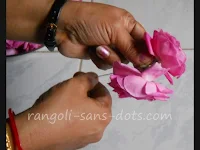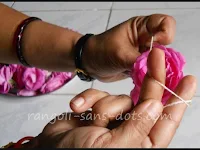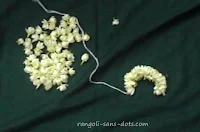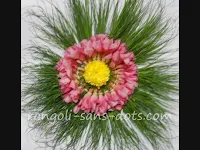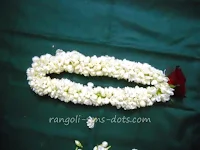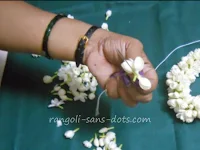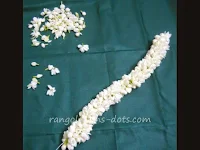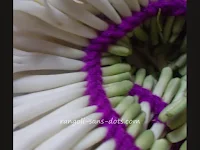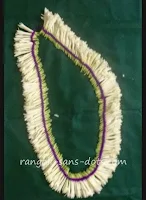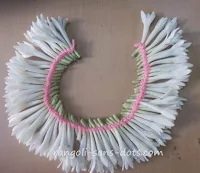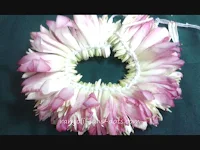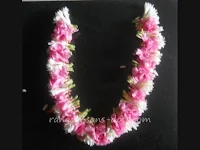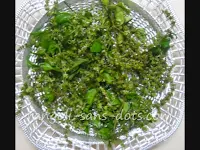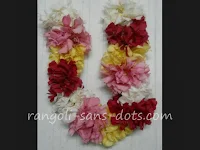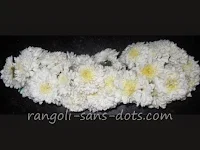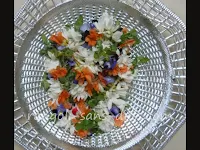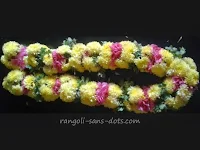Flower decorations ideas for Puja
In addition to rangoli my other interests are drawing free hand designs on thermocol plates, sarees, pottery,ceramic tiles....To put it in a nutshell -- to create (!) objects of interest using rangoli or to create interesting rangoli.Some flower decoration that are common in some parts of India are shared below. Some floral decoration ideas could be borrowed to create colourful free hand rangoli designs. So this post serves both purposes, ideas for rangoli designs and ideas for floral decorations the Indian way.
Stringing roses Indian method
.The art of stringing flowers using different methods is followed in different countries. Obviously, I would like to add the method that I am familiar with - the ones followed in Tamil Nadu,
India.
Stringing of flowers was in the past done in the family, in the house. Later this art became rare particularly in cities
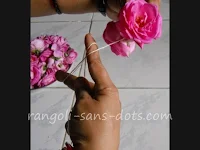
Even until a few years back, flowers were strung with vaazhai naaru (banana fibre ) and flower vendor used to pack the flowers purchased in a leaf. So very eco-friendly. Also, the flowers remain fresh for a few hours ( quite an easy and simple method of storing flowers when refrigerators were rare )
Stringing of flowers was in the past done in the family, in the house. Later this art became rare particularly in cities

Even until a few years back, flowers were strung with vaazhai naaru (banana fibre ) and flower vendor used to pack the flowers purchased in a leaf. So very eco-friendly. Also, the flowers remain fresh for a few hours ( quite an easy and simple method of storing flowers when refrigerators were rare )
These images may give answers to the question - roja poo malai kattuvadhu eppadi ( in Tamil )
The standard method of stringing flowers like jasmine is similar to that of the rose. Flowers like jasmine are not easy to be tied into a garland like the rose below. Rose is one of the most beautiful and fragrant flowers but is also difficult to string because of the delicate nature of petals and its size.
Once one gets comfortable with other flowers stringing of roses can be tried. So first one should try stringing flowers that have a long stalk. Then we can try flowers like jasmine. Some learn it tying leaves with a string.
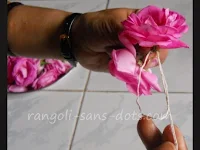
The standard method of stringing flowers like jasmine is similar to that of the rose. Flowers like jasmine are not easy to be tied into a garland like the rose below. Rose is one of the most beautiful and fragrant flowers but is also difficult to string because of the delicate nature of petals and its size.
Once one gets comfortable with other flowers stringing of roses can be tried. So first one should try stringing flowers that have a long stalk. Then we can try flowers like jasmine. Some learn it tying leaves with a string.

The first photo on the top shows the first step where the string is taken around two roses placed one 180 degrees away from the other with the string at the bottom going around the stalks of the flowers The second photo shows the fingers rolling over the string to make the knot. The third photo shows the next stage, a loop being formed. In the next stage the loop formed is inserted on the top flower and then gently the fingers are released from the string so that the knot is placed over the rose. The fifth photo shows the string being drawn to complete the knot. Again two more roses are taken, and the sequence is repeated. This is continued till we get a garland of required length. Pink roses strung for decoration, of course they can also be converted into a chendu. Due to the delicate nature of the petals ( not that other flowers are not delicate), rose petals are more delicate, the stalk is also very delicate and can break if the string is tied more than the optimum level. What is the optimum level , it comes from experience. Roses strung following the method shown above can be bunched together to form a small bouquet (chendu as it is called in Tamil )
Offering flowers with haldi and kumkum is one of the traditions of India that has been there for a long time to ladies returning home after attending a function. The concept of return gifts - as they are called has been part of India's customs and traditions. So some of the floral decorations particularly the flowers stringing type can be used as a return gift idea. Also stringing of flowers like the rose is more difficult and some of the steps are shown in the images above.
Traditional Indian flower garland
This is one of the most popular methods of making flower garlands. It is common to see men making these garlands outside temples for offering to God. These traditional garlands are also used for wedding receptions. Though many types and designs of making artificial and fresh flower and other artificial decorations combinations are used in weddings , these traditional fresh flower garlands are definitely part of wedding celebrations.
For making this garland take two or three thick banana stem fibres ( called naaru in Tamil )
Take a thin naaru and tie a knot around the thick fibres. I have used rose and marigold ( yellow samandhi )Place a rose on the thick fibre and tie the flower by taking the thin fibre around the stalk
Turn the thick fibre combination by 90 degrees, place another rose and again hold it by taking the thin stalk around.Similarly turn by 90 degrees two more times to get four flowers in the first layer of the garland
Continue this layer by layer to increase the length of the garland Finally using the thin fibre tie a knot at the bottom of the thick fibres to hold all flowers together.
Make two such floral arrangements and tie them both together at the bottom to get a complete garland
We can have a variety of combination of flowers depending upon the season and colours needed.
We can some flowers at the bottom of the garland too.
The images below show how the garland is made. I have shown a basic and sample arrangement and so the garland is some what short
Indian floral decoration ideas
This is a flower braid made from thazampoo (fragrant screw pine). The flower petals are cut to get the required design. I will upload a video for this also in the future. The top portion is shown in the image on the left. The bottom one shows a close view of the decoration. Two petals are kept one above the other and using a pair of scissors, are cut to get shapes like parallelograms. Both the pieces are removed kept on either side of the braid and stitched on it. This procedure is followed using many pairs of petals to get the interlocked design in the third image below. The stictched area is then covered with flowers or kundan designs. Finally the top is decorated with flowers and kundan designs or rakhodi surrounded with flowers.
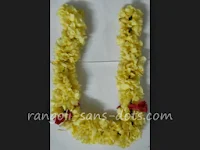 The next garland is made from oleander flowers, yellow in colour in this case. These flowers are found in white, yellow, pink and red colours, normally. These small flowers when tied closely form a beautiful garland. This garland has been formed by following the usual method of stringing flowers. Stringing a garland for flowers like marigold, roses is done with a different method.
The next garland is made from oleander flowers, yellow in colour in this case. These flowers are found in white, yellow, pink and red colours, normally. These small flowers when tied closely form a beautiful garland. This garland has been formed by following the usual method of stringing flowers. Stringing a garland for flowers like marigold, roses is done with a different method. The floral decoration on the left is a poo chendu using kanakambaram flowers. String the flowers following this method - take three flowers at a time and string all of them on one side i.e the stalk side. Then cut them so that we have many bunches with three flowers in each bunch. Using a needle and thread the stalks of each bunch are sewed to get the floral arrangement in the photo
How to make - round flower arrangement
For making a round or circular floral arrangement to get an element of the decoration above the following steps are required. The flower in this case jasmine, is tied on one side only instead of the conventional method of tying on the flowers in pairs. The result will be as shown in the second image - the tied flowers naturally form a semi circle.
As shown in the image the floral bouquet is made into a circle , the string at the loose end is cut using a pair of scissors, and the two ends of the string are tied into a knot
As shown in the image the floral bouquet is made into a circle , the string at the loose end is cut using a pair of scissors, and the two ends of the string are tied into a knot
This is floral arrangement with Bermuda grass (arugampul in Tamil), oleander (arali) and chrysanthemum (saamandhi). String a bunch of Bermuda grass blades with two oleander flowers on the top to get a decoration for Ganesh Puja. The strung flowers can be made into a circle as shown and another flower or flowers placed on the top to get a simple flower decoration. Arugampul and arali are important in the celebration of Ganesh Puja. This image could also be used to draw a free hand rangoli.The art of stringing flowers using different methods is followed in different countries.
Obviously, I would like to add the method that I am familiar with - the ones followed in Tamil Nadu, India.Stringing of flowers was in the past done in the family, in the house. Later this art became rare, particularly in cities. Even until a few years back, flowers were strung with vaazhai naaru (banana fibre ) and flower vendor used to pack the flowers purchased in a leaf. So eco-friendly.
Stringing Sampangi flowers
Sampangi (Rajnigandha in Hindi) is a long, narrow, tubular flower and so called tuberose in English. Since it is tubular in nature, stringing them in a single row is easier than in two rows as is usually done. When we try to string it in two rows we find it difficult to achieve symmetry. Due lack of stiffness the flowers also bend easily. The photo above shows how to string the flowers in two rows. From the image it is evident that we have to cut the flower at the base ( or the sepals portion ) to reduce the length. Also removing the sepals ensures that it is easier to tighten the string. It is a popular flower for various Poojas and festivals and so has been included here.
Sampangi and aralli ( oleander ) combination or kadambam is a beautiful combination for making a garland for puja. See how beautiful the light pink and white combination is. In this garland, the flowers have been tied on the one side only because of the long and narrow and hence weak nature of the white flowersThis flower is also used in kadambam garalands (a combination of three different flowers used to give a colourful effect )
Due to the presence of a long stalk these flowers can be tied or strung one side also. Take two flowers at a time (instead of placing the stalks at 180 degrees to each other place them such that petals of both flowers are on the same side. Following the usual method of stringing ( taking the string around both flowers simultaneously and tying them together following the method described in stringing roses and jasmine). However the image below will also give an idea.
Unlike the first type above where the flowers have been cut to maintain some symmetry, in this case the flowers are left making the 'garland" naturally beautiful. This flower is used in making long garlands for deities. While the image above shows a garland with champangi flowers strung on either side the photo below shows how I have strung them on one side. The result a mala like garland that can adorn photos of deities. When we string them on either side we can pack them quite closely whereas when tied on one side it appears a somewhat loosely tied garland, beautiful in its own way. Sampangi flowers in a flower pot that I take care of (!) before they were plucked to make the garland is shown in the photo below.
This method popular in Tamil Nadu is also used for making what is called poo chendu in Tamil. Unlike the stringing of flowers where we use a string and fingers to string flowers taking two at a time,, through this method we can get a thick, dense garland of flowers.
Though the resultant garland is more beautiful that the usual method of stringing due to the flowers being closely packed, it is actually easier to do. It is suitable for jasmine ( malli ). There are many more methods for making beautiful floral arrangements.
Use a needle and string as shown in the images. Take the first flower and insert in the needle so that it is horizontal.. Insert the next flower so that it faces the opposite side ( i.e 180 degrees to the first floor ). The third flower is inserted at right angles to the first two flowers. The fourth flower is inserted between the first and third flowers so that it bisects (!) the lines on which they lie.. The angle is roughly 45 degrees. Similarly, the fifth flower is inserted in the needle so that it lies on a line between the second and third flower. Push all the flowers together so that they are closely packed. Now turn the five-flower bunch 180 degrees by rotating the needle. Repeat the process - first flower horizontal, second flower is 180 degrees away from the first and so on. Each cycle has five flowers. Push the flowers closely so that you get a dense floral arrangement ( this is called poo chendu ).
The first flower is inserted in the thread. The second jasmine flower is inserted using the stalk 180 degrees away from the first flower as shown on the right.
The third flower is inserted at right angles to the first two flowers
ia five-flower bouquet rotate the arrangement by 180 degree and continue.
The final result is the floral arrangement shown below. It is used as a bridal decoration for the plaits and also for normal wear on the hair.
It can also be formed into a garland as shown. I have shown a small garland. We can make large garlands for deities or for weddings. We can also use different colours so that we get a colourful garland. Only considerations are the stalk and length of flowers chosen. We can get a very colourful and beautiful garland when we use flowers of various colours but jasmine garland is quite beautiful in its own way.
Unlike the first type above where the flowers have been cut to maintain some symmetry, in this case the flowers are left making the 'garland" naturally beautiful. This flower is used in making long garlands for deities. While the image above shows a garland with champangi flowers strung on either side the photo below shows how I have strung them on one side. The result a mala like garland that can adorn photos of deities. When we string them on either side we can pack them quite closely whereas when tied on one side it appears a somewhat loosely tied garland, beautiful in its own way. Sampangi flowers in a flower pot that I take care of (!) before they were plucked to make the garland is shown in the photo below.
This is a traditional method of tying flowers. If we find it difficult to master there is an easier method of making a garland
Easy garland - floral decoration method
Floral or flower decoration is one important aspect of celebration of events like weddings, festivals and puja. or for simply decorating our homes. One of the important methods of of flower decoration is the garland.This method popular in Tamil Nadu is also used for making what is called poo chendu in Tamil. Unlike the stringing of flowers where we use a string and fingers to string flowers taking two at a time,, through this method we can get a thick, dense garland of flowers.
Though the resultant garland is more beautiful that the usual method of stringing due to the flowers being closely packed, it is actually easier to do. It is suitable for jasmine ( malli ). There are many more methods for making beautiful floral arrangements.
Use a needle and string as shown in the images. Take the first flower and insert in the needle so that it is horizontal.. Insert the next flower so that it faces the opposite side ( i.e 180 degrees to the first floor ). The third flower is inserted at right angles to the first two flowers. The fourth flower is inserted between the first and third flowers so that it bisects (!) the lines on which they lie.. The angle is roughly 45 degrees. Similarly, the fifth flower is inserted in the needle so that it lies on a line between the second and third flower. Push all the flowers together so that they are closely packed. Now turn the five-flower bunch 180 degrees by rotating the needle. Repeat the process - first flower horizontal, second flower is 180 degrees away from the first and so on. Each cycle has five flowers. Push the flowers closely so that you get a dense floral arrangement ( this is called poo chendu ).
The first flower is inserted in the thread. The second jasmine flower is inserted using the stalk 180 degrees away from the first flower as shown on the right.
The third flower is inserted at right angles to the first two flowers
The fourth flower is inserted between the second and third flowers so that the angle is 45 degrees approximately. Similarly the fifth flower is placed so that it bisects the first and third floor ( the image is not shown here, because there are already many photos in this post and it is self-explanatory.
After forming ia five-flower bouquet rotate the arrangement by 180 degree and continue.
The final result is the floral arrangement shown below. It is used as a bridal decoration for the plaits and also for normal wear on the hair.
It can also be formed into a garland as shown. I have shown a small garland. We can make large garlands for deities or for weddings. We can also use different colours so that we get a colourful garland. Only considerations are the stalk and length of flowers chosen. We can get a very colourful and beautiful garland when we use flowers of various colours but jasmine garland is quite beautiful in its own way.
Sampangi garland - a different idea for Varalakshmi Vratham / Varamahalakshmi Pooja
Apart from the traditional method of tying flowers there is one more method of tying flowers to make a garland. The knots appear as if they resemble a pleat hairstyle ( plait ) that is common in India. Sampangi is a colloquial Tamil name commonly used by flower vendors for tuberose flower and is not to be confused with Shenbagam flowers that are yellow
Method
Follow the traditional method of tying sampangi that is described above but using this method tie two flowers together at a time and result is the garland shown in the pictures below. This type of garland is seen in floral garlands offered in some temples.
It is natural that for important festivals like Navratri and Varalakshmi Puja ( also called Varalakshmi Habba in Karnataka ) to try for some novel ideas for decorating the idol . During festivals our spirits are high and so we usually want to celebrate them to the complete satisfaction of our mind. This method of tying sampige flowers ( sampangi in Tamil ) is quite easy but the result is a different and beautiful garland. Sampangi flowers due to their slender stalk are tied at one end only.
In this method instead of tying the flowers separately, the first flower is tied , when tying the second flower the knot is inserted on both the first and second flowers so that both are tied together. Similarly, the second and third flowers are tied together, the third and fourth flowers are tied and so on. The result is that the knot shows a pleat like formation as shown in the close up image below. The tying of the knot is by following the traditional method of tying flowers.
In this method instead of tying the flowers separately, the first flower is tied , when tying the second flower the knot is inserted on both the first and second flowers so that both are tied together. Similarly, the second and third flowers are tied together, the third and fourth flowers are tied and so on. The result is that the knot shows a pleat like formation as shown in the close up image below. The tying of the knot is by following the traditional method of tying flowers.
Knots resemble a braid
This is a garland also made using the method shown above. I purchased the flowers for Rupees thirty and I could string to get three muzham. Of course, I offered it for Puja.
Another mala or string with sampangi flowers with pink (woollen ) - artificial wool that is - I tried for decorating photos of Gods and Goddesses.The next floral decoration is a combination of lotus petals and sampangi.as we say in Tamil. Since lotus petals are very delicate we cannot make a garland with them. So take two white samangi or sunganda roja as some call it in Tamil Nadu and place two lotus petals on top and tie them together. The result the garland in the image below for Varalakshmi Vratham
.
Apart from rangoli, flowers form an important part of doing puja. Many varieties of flowers are used. The image below shows kadhir pachai ( I think it is called Patchouli in English ?). Probably it belongs to the herbs category of plants.
What is important to us is the fragrance. Most important the fragrance even after it has dried. It is used as it is or strung with other flowers in a kadambam. (malli, kanakambaram and kadhir pachai giving fragrance along with a red, white and green colour combination ) Mehandi flowers ( marudhani poo in Tamil ) is also used instead of kadhir pachai in this combination . Rangoli and flowers complement each other in the performance of puja. To state the obvious, there are many beautiful and colourful varieties of flowers available through nature. Just we have many varieties and types in rangoli designs that may be plain or colourful so also there can be different possible of floral decorations that can be used for puja and for many other festivals and occasions.
Of these one of the methods of floral decoration is the arrangement of flowers in the form of a garland. Here we can have a single flower or a combination of flowers (some standard combinations have been there for quite a long time, I guess ). For example floral garlands can be with roses, jasmine, saamandhi as it is called in Tamil to name a few.
What I have tried here is a combination of (nerium ) oleander flowers. I have used in the order white, dark pink, yellow and pink oleander flowers and strung them to form a beautiful garland. It just to try something new. However, the actual garland is more beautiful to look at that what we see in a photo. This is one variety of floral decoration. There can be many combinations that are there and that can be done.
This called December poo (Decemeber flower in Tamil ) because it found during this season. It comes in many colours white violet, pink and a combination of violet with white streaks are common. I understand that it is called Philippine violet in English.
Flowers are a main source of inspiration for many rangoli designs both for drawing and colouring. Take for example the oleander - it is many colours white, yellow, pink and dark pink to name a few. So also chrysanthemum exists in white and yellow also!. Floral decoration, stringing of flowers is an important craft. There are numerous methods of floral decorations.
The two images below - white chrysanthemum and dark pink oleander (aralli in Tamil ) strung with a string - following the Indian method. Flowers can be tied very closely as shown or they can be strung with a little distance between a pair or a set of flowers. Stringing of oleander should be done before the flower blooms fully, it is easier then.
Otherwise the petals will bend backwards and we may find it difficult to tie them. To know more floral decoration ideas and to see how flowers are tied with a string go to my YouTube Channel Rangolisansdots
Of these one of the methods of floral decoration is the arrangement of flowers in the form of a garland. Here we can have a single flower or a combination of flowers (some standard combinations have been there for quite a long time, I guess ). For example floral garlands can be with roses, jasmine, saamandhi as it is called in Tamil to name a few.
What I have tried here is a combination of (nerium ) oleander flowers. I have used in the order white, dark pink, yellow and pink oleander flowers and strung them to form a beautiful garland. It just to try something new. However, the actual garland is more beautiful to look at that what we see in a photo. This is one variety of floral decoration. There can be many combinations that are there and that can be done.
This called December poo (Decemeber flower in Tamil ) because it found during this season. It comes in many colours white violet, pink and a combination of violet with white streaks are common. I understand that it is called Philippine violet in English.
Flowers are a main source of inspiration for many rangoli designs both for drawing and colouring. Take for example the oleander - it is many colours white, yellow, pink and dark pink to name a few. So also chrysanthemum exists in white and yellow also!. Floral decoration, stringing of flowers is an important craft. There are numerous methods of floral decorations.
The two images below - white chrysanthemum and dark pink oleander (aralli in Tamil ) strung with a string - following the Indian method. Flowers can be tied very closely as shown or they can be strung with a little distance between a pair or a set of flowers. Stringing of oleander should be done before the flower blooms fully, it is easier then.
Otherwise the petals will bend backwards and we may find it difficult to tie them. To know more floral decoration ideas and to see how flowers are tied with a string go to my YouTube Channel Rangolisansdots
Flowers are an important part of festivals and puja and are given a lot of importance in India. There are different methods of floral decorations that are used and that are possible. Once such idea is the combination of different flowers and stringing the in a particular pattern. The pattern depends upon the colour of the flowers. There are some standard combinations.
Of course we can also experiment to find a new and beautiful combination with wide variety of flowers nature has provided us. Some flowers have a lot of fragrance, some are not. So we have to choose at least one flower that smells sweet. Such a combination of flowers is called kadambam in Tamil.
Of course we can also experiment to find a new and beautiful combination with wide variety of flowers nature has provided us. Some flowers have a lot of fragrance, some are not. So we have to choose at least one flower that smells sweet. Such a combination of flowers is called kadambam in Tamil.
. The image shows a garland rolled in to a bouquet (chendu in Tamil ).
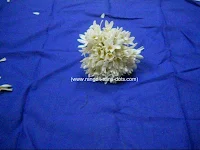
Flowers can be formed as a ring after stringing them and can be used for decoration. I have used light pink, yellow and white oleander ( called aralli in Tamil and kaner in Hindi ?) flowers. One or two such decorations have been shown at the top.
Following the usual stringing method the ends have been tied to get a ring like formation. he following pictures show some of the ideas that can be done using rings formed by oleander. The first one is a combination of pink and yellow with roses at the centre. The second one is a combination of
The next picture on the right shows the oleander or arali flowers mounted on a stick. A useful and simple method of flower decoration for ornamental purposes.Following the usual stringing method the ends have been tied to get a ring like formation. he following pictures show some of the ideas that can be done using rings formed by oleander. The first one is a combination of pink and yellow with roses at the centre. The second one is a combination of
There are many more methods of floral decoration ideas that are there in public domain or that can be invented. I will add them as and when I try them.
Another combination of flowers ( samandhi, aralli and maru in Tamil ) can be used to make a beautiful garland again the combination of colours yellow, pink and green makes the garland very attractive. The fragrance is high in maru leaves, while in chrysanthemum (samandhi ) there is mild fragrance and aralli ( or oleander has no such property.
